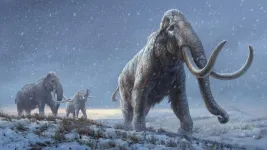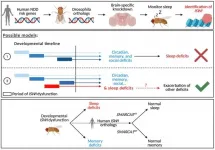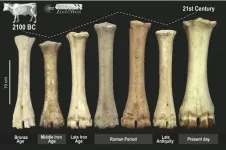INFORMATION:
The study is the result of an international collaboration that has involved 22 scientists from nine countries. In addition to researchers from the Centre for Palaeogenetics, a joint research centre funded by Stockholm University and the Swedish Museum of Natural History, the study also includes researchers from the Russian Academy of Sciences, the Natural History Museum and The Crick Institute in the United Kingdom, UC Santa Cruz in the USA, Potsdam University in Germany, China Agricultural University, the Middle East Technical University in Turkey, the Arctic University of Norway, and the University of Copenhagen in Denmark.
World's oldest DNA reveals how mammoths evolved
2021-02-17
(Press-News.org) An international team led by researchers at the Centre for Palaeogenetics in Stockholm has sequenced DNA recovered from mammoth remains that are up to 1.2 million years old. The analyses show that the Columbian mammoth that inhabited North America during the last ice age was a hybrid between the woolly mammoth and a previously unknown genetic lineage of mammoth. In addition, the study provides new insights into when and how fast mammoths became adapted to cold climate. These findings are published today in Nature.
Around one million years ago there were no woolly or Columbian mammoths, as they had not yet evolved. This was the time of their predecessor, the ancient steppe mammoth. Researchers have now managed to analyse the genomes from three ancient mammoths, using DNA recovered from mammoth teeth that had been buried for 0.7-1.2 million years in the Siberian permafrost.
This is the first time that DNA has been sequenced and authenticated from million-year-old specimens, and extracting the DNA from the samples was challenging. The scientists found that only minute amounts of DNA remained in the samples and that the DNA was degraded into very small fragments.
"This DNA is incredibly old. The samples are a thousand times older than Viking remains, and even pre-date the existence of humans and Neanderthals", says senior author Love Dalén, a Professor of evolutionary genetics at the Centre for Palaeogenetics in Stockholm.
The age of the specimens was determined using both geological data and the molecular clock. Both these types of analyses showed that two of the specimens are more than one million years old, whereas the third is roughly 700 thousand years old and represents one of the earliest known woolly mammoths.
An unexpected origin of the Columbian mammoth
Analyses of the genomes showed that the oldest specimen, which was approximately 1.2 million years old, belonged to a previously unknown genetic lineage of mammoth. The researchers refer to this as the Krestovka mammoth, based on the locality where it was found. The results show that the Krestovka mammoth diverged from other Siberian mammoths more than two million years ago.
"This came as a complete surprise to us. All previous studies have indicated that there was only one species of mammoth in Siberia at that point in time, called the steppe mammoth. But our DNA analyses now show that there were two different genetic lineages, which we here refer to as the Adycha mammoth and the Krestovka mammoth. We can't say for sure yet, but we think these may represent two different species", says the study's lead author Tom van der Valk.
The researchers also suggest that it was mammoths that belonged to the Krestovka lineage that colonised North America some 1.5 million years ago. In addition, the analyses show that the Columbian mammoth that inhabited North America during the last ice age, was a hybrid. Roughly half of its genome came from the Krestovka lineage and the other half from the woolly mammoth.
"This is an important discovery. It appears that the Columbian mammoth, one of the most iconic Ice Age species of North America, evolved through a hybridisation that took place approximately 420 thousand years ago", says co-lead author Patrícia Pečnerová.
Evolution and adaptation in the woolly mammoth
The second million-year-old genome, from the Adycha mammoth, appears to have been ancestral to the woolly mammoth. The researchers could therefore compare its genome with the genome from one of the earliest known woolly mammoths that lived 0.7 million years ago, as well as with mammoth genomes that are only a few thousand years old. This made it possible to investigate how mammoths became adapted to a life in cold environments and to what extent these adaptations evolved during the speciation process.
The analyses showed that gene variants associated with life in the Arctic, such as hair growth, thermoregulation, fat deposits, cold tolerance and circadian rhythms, were already present in the million-year-old mammoth, long before the origin of the woolly mammoth. These results indicate that most adaptations in the mammoth lineage happened slowly and gradually over time.
"To be able to trace genetic changes across a speciation event is unique. Our analyses show that most cold adaptations were present already in the ancestor of the woolly mammoth, and we find no evidence that natural selection was faster during the speciation process", says co-lead author David Díez-del-Molino.
Future research
The new results open the door for a broad array of future studies on other species. About one million years ago was a period when many species expanded across the globe. This was also a time period of major changes in climate and sea levels, as well as the last time that Earth's magnetic poles changed places. Because of this, the researchers think that genetic analyses on this time scale have great potential to explore a wide range of scientific questions.
"One of the big questions now is how far back in time we can go. We haven't reached the limit yet. An educated guess would be that we could recover DNA that is two million years old, and possibly go even as far back as 2.6 million. Before that, there was no permafrost where ancient DNA could have been preserved", says Anders Götherström, a professor in molecular archaeology and joint research leader at the Centre for Palaeogenetics.
ELSE PRESS RELEASES FROM THIS DATE:
Mentally ill kids become less healthy adults
2021-02-17
DURHAM, N.C. -- A new pair of studies from a Duke research team's long-term work in New Zealand make the case that mental health struggles in early life can lead to poorer physical health and advanced aging in adulthood.
But because mental health problems peak early in life and can be identified, the researchers say that more investment in prompt mental health care could be used to prevent later diseases and lower societal healthcare costs.
"The same people who experience psychiatric conditions when they are young go on to experience excess age-related physical diseases and neurodegenerative diseases when they are older adults," explained Terrie Moffitt, the Nannerl O. Keohane professor ...
A 'twisted elevator' could be key to understanding neurological diseases
2021-02-17
A University of Sydney-led international team of scientists has revealed the shape of one of the most important molecular machines in our cellsthe glutamate transporter, helping to explain how our brain cells communicate with one another.
Glutamate transporters are tiny proteins on the surface of all our cells that shut on and off the chemical signals that have a big role in making sure all cell-to-cell talk runs smoothly. They are also involved in nerve signalling, metabolism and learning and memory.
The researchers captured the transporters in exquisite detail using cryogenic electron microscopy (cryo-EM), showing they look like a 'twisted elevator' embedded in the cell membrane.
This world-first discovery ...
One in five has a mutation that provides superior resilience to cold
2021-02-17
Almost one in five people lacks the protein α-actinin-3 in their muscle fibre. Researchers at Karolinska Institutet in Sweden now show that more of the skeletal muscle of these individuals comprises slow-twitch muscle fibres, which are more durable and energy-efficient and provide better tolerance to low temperatures than fast-twitch muscle fibres. The results are published in the scientific journal The American Journal of Human Genetics.
Skeletal muscle comprises fast-twitch (white) fibres that fatigue quickly and slow-twitch (red) fibres that are more resistant to fatigue. The protein α-actinin-3, which is found only ...
Robotic dogs & laughter therapy: combating loneliness & isolation while social distancing
2021-02-17
Robotic dogs, laughter therapy and mindfulness are some of the ways that might help people - particularly the elderly - cope with loneliness and social isolation while social distancing, say researchers at the University of Cambridge.
A team at Cambridge's School of Medicine carried out a systematic review looking at the existing evidence on different approaches to tackling loneliness and social isolation. While all the individual studies were carried out pre-pandemic, the team considered which approaches might be feasible when people are still required to socially distance. Their results are published today in PLOS ONE.
At the start of the pandemic in the UK, over 1.5 million people were told they must self-isolate ...
Lakes isolated beneath Antarctic ice could be more amenable to life than thought
2021-02-17
Lakes underneath the Antarctic ice sheet could be more hospitable than previously thought, allowing them to host more microbial life.
This is the finding of a new study that could help researchers determine the best spots to search for microbes that could be unique to the region, having been isolated and evolving alone for millions of years. The work could even provide insights into similar lakes beneath the surfaces of icy moons orbiting Jupiter and Saturn, and the southern ice cap on Mars.
Lakes can form beneath the thick ice sheet of Antarctica where the weight of ice causes immense pressure at the base, lowering the melting point of ice. This, coupled with gentle heating from rocks below and the insulation provided by the ice from the cold air above, allows pools of liquid water ...
Researchers find diverse supportive partnerships among older gay men with and without HIV
2021-02-17
WASHINGTON --- Recent data reveals that gay men living with HIV report having supportive relationships with family, friends, or in informal relationships rather than with primary romantic partners, while gay men who are HIV negative report having relationships mainly with primary partners. Additionally, gay men living with HIV were more likely to report no primary or secondary supportive partnerships compared to men who are HIV negative. The analysis was led by researchers at Georgetown University Medical Center.
Along with successful HIV treatments, it is known that the presence of social support impacts long-term survival among men living with HIV. However, little has been known about the types of ...
High-risk gene for neurodevelopmental disorders linked to sleep problems in flies
2021-02-17
PHILADELPHIA - The mutation of a gene that has been associated with neurodevelopmental disorders like autism spectrum disorder led to marked sleep disturbances in fruit flies, according to a new study from scientists in the Perelman School of Medicine at the University of Pennsylvania. The findings, published Wednesday in Science Advances, provide further evidence that sleep is linked to early neurodevelopmental processes and could guide future treatments for patients.
While sleep disruption is a commonly reported symptom across neurodevelopmental disorders, including autism, it is often treated clinically as a "secondary effect" ...
Changing livestock in ancient Europe reflect political shifts
2021-02-17
In ancient European settlements, livestock use was likely primarily determined by political structure and market demands, according to a study published February 17, 2021 in the open-access journal PLOS ONE by Ariadna Nieto-Espinet and colleagues of the Consejo Superior de Investigaciones Científicas, Barcelona.
Zooarchaeology - the study of animal remains from archaeological sites - has great potential to provide information on past human communities. Livestock preferences are known to have changed over time in Europe, but little is known about how much these changes are influenced by environmental, economic, or political conditions of ancient settlements.
In ...
More sustainable recycling of plastics
2021-02-17
The new method works without extremely high temperatures, is therefore more energy-efficient and has a significantly higher recovery rate (approx. 96 per cent of the starting material) than established processes. These findings will be published on 17 February 2021 in the scientific journal Nature.
Mechanical recycling vs. chemical recycling
"The direct re-utilization of plastics is often hampered by the fact that, in practice, mechanical recycling only functions to a limited degree - because the plastics are contaminated and mixed with additives, which impairs the properties ...
This robot doesn't need any electronics
2021-02-17
Engineers at the University of California San Diego have created a four-legged soft robot that doesn't need any electronics to work. The robot only needs a constant source of pressurized air for all its functions, including its controls and locomotion systems.
The team, led by Michael T. Tolley, a professor of mechanical engineering at the Jacobs School of Engineering at UC San Diego, details its findings in the Feb. 17, 2021 issue of the journal Science Robotics.
"This work represents a fundamental yet significant step towards fully-autonomous, electronics-free walking robots," said Dylan Drotman, a Ph.D. student in Tolley's research group and the paper's first author.
Applications include low-cost robotics for entertainment, such ...




